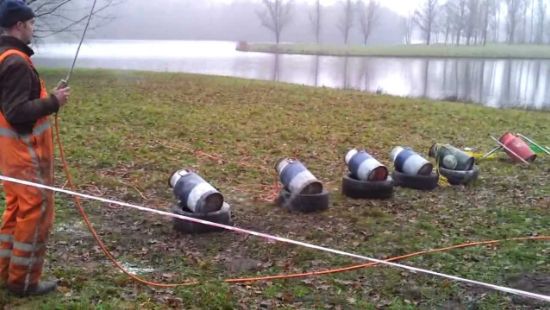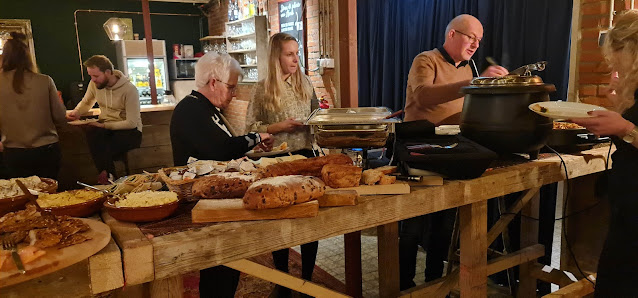Week 32 "Cry When You See Me"
Week 32 Drought and other thoughts
A mixed bag this week.
Slowly getting back to "normal". It was good to be back with the clients again - it's easy to forget sometimes that we are an important part of their lives.
I caught up with my mowing, but it hasn't been growing much because of the drought. A lot of it is dead!
Bookkeping uptodate.
The nitrogen debate continues...
The drought is a worry - with water shortages and added transport problems
Gas prices continue to rise
We picked up a lot of Ben's belongings on Sunday - he has sublet his apartment as he prepares to head off for 8 months! Bangkok, Australia, Mexico, USA (I'm not happy about that one).
The drought seems to have taken up a fair bit of my reading time...
About peat
(Peat is a far greater absorber of CO2 than trees...)
The pink/purple bits are " water and CO2 holding capacity in historical peat areas".
Trees per neighbourhood
A podcast about a (dramatically) failed attempt (in Scotland) to clear peat bogs and plant trees instead...
This coincided exactly with a 3 km walk!
I was reminded of the Netherlands own peat bogs (particularly in Friesland and Drenthe) and of the vital role that peat played in the Golden Century of the Netherlands cultural and economical development (as an energy source).
And not to mention that we now enjoy using the canals that were once used to transport peat to the major population centres "down south".
Water levels on the Rhine River are set to fall perilously close to the point at which it would effectively close, according to German data. This puts the trade of huge quantities of goods at risk and also hampers EU plans to increase the movement of goods along waterways by 25 percent by 2030, as part of efforts to slash emissions from the transport sector.
There is also concern about water levels falling in moorings where wooden ships are kept - they must be kept in water to keep the timbers watertight.
"Cry when you see me." This can be read on a dried up stone in the river Elbe. The message is a warning from the past: very low river levels used to be a sign of crop failure and hunger. 'Hungersteine' have also been found on dry parts of the bed of the river Rhine.
In the Netherlands, never before has so little water flowed through the Rhine.
Recent figures released by the European statistics office Eurostat reveal that those working in the Netherlands have, on average, a longer working life than those living in other countries in Europe. Dutch people can now expect to spend a total of 42,5 years of their lives working, compared to the European average of 36 years.
The Drought in Europe
According to recent data released by the European Drought Observatory, 60 percent of Europe and the United Kingdom is currently in danger of drought.
The findings were based on data from a 10-day period near the end of July, which found 45 percent of the bloc's territory was under drought warning conditions by mid-July.
In addition, 15 percent was on red alert, meaning severe water deficiency.
The EU's climate monitoring agency Copernicus likewise reported on Monday (8 August) that Europe continued to swelter in July, with temperatures topping 40 degrees Celsius for at least one day in Spain, France, and the United Kingdom.The UK saw a national daily maximum temperature record of 40.3°C — the first time the country ever recorded a temperature of over 40°C.
The May-to-July period was also the driest on record in Spain with water reserves at an all-time low of 40 precent, according to the country's meteorological agency.
The Dutch government officially declared a water shortage on Wednesday.
On Friday, French prime minister Élisabeth Borne announced unprecedented water restrictions, banning people from watering their lawns, washing their cars, and preventing farmers from irrigating crops.
France recorded its driest July in more than 60 years, with just 9.7 millimetres of rain.
As a result, more than 100 French municipalities have no running drinking water and are being supplied by truck.
According to a forecast published two weeks ago by the EU's Joint Research Centre, heat and drought may lead to an 8 to 9 percent drop in the production of grain maize, sunflowers, and soybeans in Europe.
River transport is also affected, as water levels continue to fall across the bloc.
The Kaub measuring point on the Rhine river, by far the most important water transport route in Europe, was down to 49 centimetres on Sunday, taking it to within 9 centimetres of being all but impassable.
Wildfire
Drought conditions have also led to an increase in wildfires, with multiple records broken, especially in the Mediterranean, as an area more than twice the size of Rome has gone up in flames in July alone.
The EU's Forest Fire Information System (EFFIS) recorded a total burnt area of 587,868 hectares in the European Union on 30 July since the beginning of the year, compared with an average of around 158,000 hectares for the 2006-2021 reference period.
If you don't want to talk about sustainable changes, don't complain. The farmers have not yet done much to enter into discussions with the government. And when there was a conversation, the result was zero point zero and the farmers shouted that the government does not want to cooperate for sustainable solutions. In the meantime, the farmers managed to break down the door of the Frisian provincial house, put rubbish on the highways and other such (un)democratic means. Many promotions were not public-friendly.
Discharge ban extended. (Discharge from boat/ship toilets)
Gas Prices (now at €3,00 per m3)
The Netherlands now has the highest gas price in Europe, having overtaken Sweden in the past few weeks, according to an analysis by website Energievergelijk.nl.
Still Working...
Recent figures released by the European statistics office Eurostat reveal that those working in the Netherlands have, on average, a longer working life than those living in other countries in Europe. Dutch people can now expect to spend a total of 42,5 years of their lives working, compared to the European average of 36 years.
The Drought in Europe
According to recent data released by the European Drought Observatory, 60 percent of Europe and the United Kingdom is currently in danger of drought.
The findings were based on data from a 10-day period near the end of July, which found 45 percent of the bloc's territory was under drought warning conditions by mid-July.

According to data released by the European Drought Observatory 60 percent of Europe and the United Kingdom is in a state of drought. (Photo: European Drought Observatory)
In addition, 15 percent was on red alert, meaning severe water deficiency.
The EU's climate monitoring agency Copernicus likewise reported on Monday (8 August) that Europe continued to swelter in July, with temperatures topping 40 degrees Celsius for at least one day in Spain, France, and the United Kingdom.The UK saw a national daily maximum temperature record of 40.3°C — the first time the country ever recorded a temperature of over 40°C.
The May-to-July period was also the driest on record in Spain with water reserves at an all-time low of 40 precent, according to the country's meteorological agency.
The Dutch government officially declared a water shortage on Wednesday.
On Friday, French prime minister Élisabeth Borne announced unprecedented water restrictions, banning people from watering their lawns, washing their cars, and preventing farmers from irrigating crops.
France recorded its driest July in more than 60 years, with just 9.7 millimetres of rain.
As a result, more than 100 French municipalities have no running drinking water and are being supplied by truck.
According to a forecast published two weeks ago by the EU's Joint Research Centre, heat and drought may lead to an 8 to 9 percent drop in the production of grain maize, sunflowers, and soybeans in Europe.
River transport is also affected, as water levels continue to fall across the bloc.
The Kaub measuring point on the Rhine river, by far the most important water transport route in Europe, was down to 49 centimetres on Sunday, taking it to within 9 centimetres of being all but impassable.
Wildfire
Drought conditions have also led to an increase in wildfires, with multiple records broken, especially in the Mediterranean, as an area more than twice the size of Rome has gone up in flames in July alone.
The EU's Forest Fire Information System (EFFIS) recorded a total burnt area of 587,868 hectares in the European Union on 30 July since the beginning of the year, compared with an average of around 158,000 hectares for the 2006-2021 reference period.
The farmers' nitrogen crisis.
Many large agriculture companies have refused to attend talks with the government - they say they are "in support" of the farmers - the cynic in me says that it is all about money, as usual...
There is a lot at stake for companies. If the government's nitrogen plans go ahead, this is expected to lead to a significant reduction in livestock. If farmers keep fewer animals, that means less animal feed, fewer stables and less milk. And that means less turnover...
I read nu.nl quite a lot. The readers' comments are always interesting...
...this one from Thursday's nu.nl (Google Translate)
And now for the argument of the agro-industry that the government should first talk constructively with the farmers. The farmers must understand that we live in a democratic constitutional state, and the industry must understand that mega profits are a thing of the past. We don't have to agree, but we do have to respect and listen to each other. Farmers and agro-industry are not open to listening. So the government can just continue with their policies. That's my opinion.
The ban on the discharge of waste water will be tightened as of 1 January 2025. Passenger ships and hotel ships of 12 or more persons may then no longer discharge domestic waste water. Now the limit is still 50 people. The ban takes effect on two occasions, depending on the year of construction of the ship. Ships built after 2008 must already have a waste water tank on board. For them, the ban on discharging waste water into surface waters will come into effect on 1 January 2025. Ships from before 2008 will be given a little longer and must have a waste water tank on board from 1 January 2030 when the certificate is renewed.
Domestic wastewater is wastewater from kitchens, dining areas, washrooms and utility rooms, as well as toilet water. The discharge ban for passenger ships is stricter than the discharge ban for pleasure craft. Pleasure craft are not allowed to discharge toilet water from the main message (No. 2).
The small message (No. 1) and household waste water may still be discharged. Frequently heard criticism of this discharge ban is that other ships are still allowed to discharge. That will soon no longer be the case and passenger ships will soon be subject to a stricter discharge ban.






Comments
Post a Comment